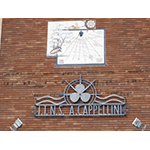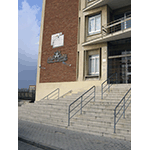Istituto Tecnico Nautico "Alfredo Cappellini" ["Alfredo Cappellini" Technical Nautical Institute]
The Institute has its roots in the Governmental Nautical School, established at Livorno in 1766 by Grand Duke Peter Leopold of Lorraine for the instruction of pilots. The school, founded by a Royal Decree of December 13, 1863, was the first technical institute in the Province of Livorno. When nautical institutes were put under the authority of the Ministry of the Navy, the Nautical Institute was detached from the commercial section in 1921 and, in 1923, was named after Frigate Captain Alfredo Cappellini. It possesses a collection of model ships in wood and plastic, dating mainly from the first half of the 20th century. The collection also includes models of engine rooms, among them a big plastic model of the pipings and a metal model of a steam engine.
The collection of educational instrumentation includes naval machines and apparatus (anchors, engines, boilers and steam turbines) and instruments for navigation (spheroscopes, binnacles and compasses, binoculars, sextants, depth-sounders, telegraph machines and astronomical instruments), all dating from the late 19th to the mid-20th century. Noteworthy are two anchors, one dating from Roman times, the other from the 16th century. The collection also includes historic instruments from the physics laboratory (scales, electrostatic machines, inclined planes and glassworks), dating from the early years of the 20th century. Torricellian barometers and various measurement instruments are found in the meteorological laboratory.
The Institute has a collection of around 200 nineteenth-century prints illustrating models, projects and construction plans for ships. The walls are hung with late nineteenth-century plates representing steam-driven machines, coming from the Orlando Shipyards in Livorno.
The Institute has laboratories of Physics, Navigation, Meteorology and Naval Art, in which the instruments from the collections are used for teaching purposes. It also has a Planetarium and a Centre of Marine Meteorology and Environmental Monitoring of the Mediterranean (LAMMA). The facade of the building is decorated with a fine sundial.
****************************
Texts by Francesco Marchetti
English translation by Catherine Frost
Last update 05/gen/2008





